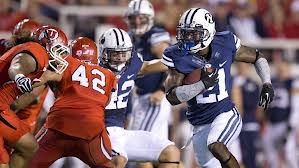BYU's Top RB: Stinger, Concussion ... Lucky, for Now
Published on 22-Sep-2013 by J Square Humboldt
Share this article

On a day when a handful of college football players mounted a low-key protest that could become a movement, BYU's leading rusher gave them the latest reason to be concerned.
It was almost too much of a reason.
In the midst of falling to heated rival Utah for a fourth straight year, Jamaal Williams was handed the ball on a fourth-and-one at the Ute 29. The 6-3, 200lb sophomore was the logical option, having entered the game with 326 yards on 63 carries already this season.
Williams got the job done, but his form was less than optimum. He went into the ill-advised 'battering ram' mode:

The resultant collision drove Williams into the ground head-first. He got the first down, but that immediately became secondary.
Williams couldn't move.
A boisterous throng of 62,000 fell hushed as medical staff raced to the scene. The running back was taken from the field on a stretcher. His mother arrived in the tunnel and was the first to indicate that her son had dodged a tragedy:

The fact he was moving lessened the incident from a Code Red, releasing a wave of relief from any and all.
It was later reported that Williams had suffered a concussion and severe stinger.
No sport involving high-speed collisions is ever going to be devoid of catastrophic injuries, so the issue here is not just one of safety, but one of measures taken to those who aren't as lucky as Jamaal Williams.
Say what you want about Johnny Manziel's escapades and autographing enterprise, he's definitely raised the awareness of just where college athletes should stand in the grand scheme of a multi-billion-dollar industry overseen by non-profit institutions.
Now, the players themselves are beginning to organize.
The situation is complicated, so they can't expect simple solutions. For example:
- If athletes in revenue-generating sports are to be paid, should they also be required to graduate? And would this leave schools open to legal claims of discrimination by athletes in non-revenue sports?
- Virtually all NFL players come from colleges, saving them the massive expense of maintaining a farm system. Should they be pressured into providing more financial support from the kajillions of dollars they receive? But if they disagree, what meaningful grounds do schools have to apply any pressure?
Fortunately, this summer, the NCAA bolstered financial resources available to athletes who suffer catastrophic injuries, But more needs to be done. It still prohibits players from insuring against their perceived market value. Why? Their stipend of $100,000 annually is good, but most families of paralyzed individuals will confirm that amount goes quickly. $306,000 annually is a ballpark figure; how are most families supposed to come up with that?
It's a quesion Jamaal Williams' family won't need to answer. But sooner or later, someone will. Again.

